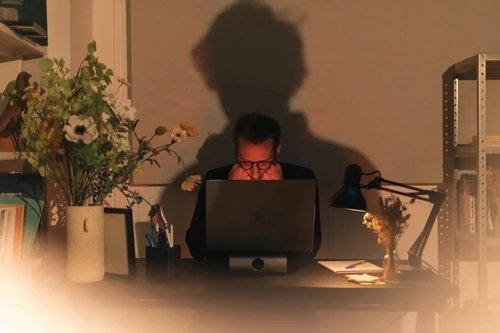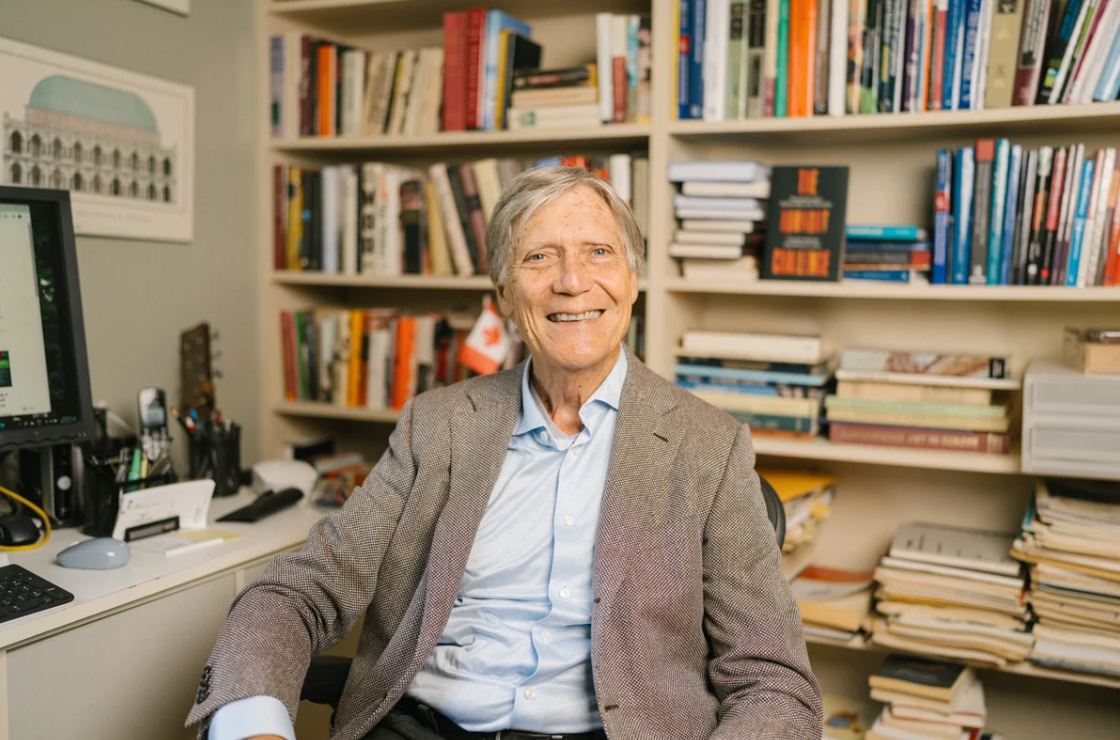“Burnout is a relationship problem”: A conversation with Michael Leiter
04 oct. 2023
8min


Journalist
Five decades after the term made its way into the mainstream vocabulary in the 1970s, “burnout” has reached the status of a folk illness. In the US alone, hundreds of billions of dollars are lost each year to work-related stress and it’s been cited as one of the main reasons a record number of workers quit their jobs in 2021. But what does burnout actually mean? How does it differ from exhaustion and depression? And, more importantly, why has it become an accepted fact of working life?
To find out, we spoke with Michael Leiter, a professor of psychology at Acadia University in Canada who has spent more than forty years studying ways to identify and combat burnout. In his new book, The Burnout Challenge: Managing People’s Relationship with Their Jobs, he and co-author Christina Maslach cite decades worth of scientific data to deflate the stubborn myth that employees can ward off burnout on their own. The result is a 270-page, evidence-driven guide to how managers can promote better health and employee productivity — all while laying the groundwork for broader reforms.
Can you tell us a little bit about how this book came to be? You’ve been writing about the concept of burnout for a long time, has your understanding of it changed over the years? Why is it such a relevant topic today?
Well, Christina and I have been working together on burnout since the 1980s, and what we are looking at with this book is a sort of summary piece. We were reading a lot of things that talked about burnout in terms of resilience and that “if people were only tougher, burnout wouldn’t be a problem.” But that’s not really how we’re looking at it, we’re looking at it as a health problem. Burnout is a kind of existential crisis that people experience with their work. In that way, it becomes more useful to think about it as a relationship problem, the relationship between work and people.
Even well-managed workplaces can be bumpy for people some of the time, so it’s about what’s going on between the person and the setting. People are complicated and workplaces are complicated. So there are a lot of ways where things can mismatch between what a person is looking for, and what the workplace is looking for. We’re framing out the idea that burnout is a breakdown in the relationship between people and workplaces. Sending people to therapy isn’t a practical way of dealing with the problem and neither is changing the workplace and trying to be perfect for everybody. People are not all exactly the same, so the issue becomes flexibility, awareness, and responsiveness. So, it really goes into how you manage things, and we felt that now was a timely moment to get that message out.
You talked about burnout being perceived as a health problem, and many of the symptoms of burnout can mimic other things like depression and anxiety. So how can we differentiate? How do you identify burnout as a separate issue?
Burnout is very work-focused, whereas depression doesn’t really respect boundaries. Burnout really has a lot to do with the workplace, it’s a combination of exhaustion, cynicism, and discouragement. Think about diagnosing illnesses: if you said that every illness that has a fever is the same illness, you wouldn’t get very far. When you focus on burnout as a workplace issue, it gives you some specific actions to take. When we’re talking to people in leadership positions, what we’re looking for them to do is solve management problems and not be psychotherapists.
There’s a bit of a debate around whether the responsibility is on management or on the individual, and in this book you’re exploring who bears the onus of burnout. Why did you feel the need to emphasize that?
Well, I think we’re emphasizing that it’s really a relationship problem. You’re going to be able to have a bigger impact if you work together on a problem rather than telling one party to go get themselves straightened out. That’s not really the model. Individuals need to adapt what they’re doing, too. It isn’t like you go to work and everything’s just the way you would like to be. So, it’s about finding out how we can sort this out together so that not only are individuals contributing, but they are finding fulfillment and purpose. People are looking for a sense of belonging to a group that both respects and values them. Individuals have to take the leap sometimes to try new things and push the boundaries. It’s about having enough confidence in yourself and a bit of trust in the people running things. If you’re always saying, “Oh, I can’t do anything because I’ll get in trouble,” then you’re never quite tested. I’d say, “Well, how much trouble could you get into?”
When you talk about the fulfillment people are seeking in their work and the effects of not having it, do you think that’s a reflection of changing ideals about work over generations? Today, we have young workers coming in with more expectations of having a job that they’re passionate about. Do you think the workplace has failed to keep up with those expectations?
That is certainly part of it. When I look at a big dataset to see who’s really having the hardest time with elements of burnout, it’s often on the younger side of the scale. If you lasted until your fifties working in this environment, you must have something figured out. You know, kids are being brought up differently, and these ideas of identity and community values are something that insists on respect. For a long time it was “forget about your values, when you come to work you are part of your company,” and that’s really different now. Again, managers are just gradually figuring this out, some begrudgingly, some enthusiastically.
You’re obviously well-versed in this topic. When writing this book, was there anything that surprised you or signaled a new trend in the past few years?
I was struck by how broadly the word burnout is used in different contexts, but what I call burnout is a much more serious thing. People use it colloquially, saying “I had a hard day, I feel really burned out.” That’s a legitimate way to talk about it, but it’s not how I talk about it. We find with a lot of people that the issue is just exhaustion. There’s too much work to do and they’re not getting enough rest, but they still really love what they’re doing and think they’re accomplishing great things. Now we have a better understanding of how that’s different from being truly burned out. If you’re not cynical, just overextended, that’s a more straightforward problem to address.
When somebody is really burned out, they are so cynical and distrustful that they’re not open. People who are burned out have no confidence in themselves, and they’ve lost that sense of efficacy, that sense of belief in themselves. So, somebody who’s still confident about their abilities, that’s an easier problem to solve, and it’s important to distinguish those things or you can end up wasting a lot of effort trying to help people with something they don’t really need help with.
Are there any concrete practices you’d like to see become standard in the workplace?
I think it just comes back to those basic psychological markers, the sense of belonging and the idea of efficacy. In a workplace, you want experiences that affirm you as a capable, important contributor. Autonomy, latitude, and initiative have importance to varying degrees, and as you gain more experience, you’ll want more autonomy and more confirmation of your efficacy and your capabilities. One of the projects I’ve been working on is improving workgroup civility. In work groups where people are being snarky to each other, or not really connecting with each other, they’re sort of working on parallel lines. So, we need to get down to some basics of asking “How do you show appreciation to other people?” I think that most people get along fine at work, but when you find that it’s really strained or people are feeling lonely, you need to get in there and get something positive going or there’s going to be a real lapse.
For workers who feel like they might be in a situation that’s inducing burnout, do you have any specific methods to identify it?
Well, there are questionnaires that work on a workgroup level, but they’re not really for individuals. For individuals, there are symptoms like feeling tired at the beginning of the work day, before your day job even begins. If that’s a regular part of your life, then burnout is something you need to consider. Let’s say you used to love work. You used to care about it and thought you were going to be able to do great things, but now you can’t stand it. That’s where it starts signaling burnout. The question is, how frequently are you on the negative side of things? Because an ideal work situation is fulfilling, and a lot of people do have jobs that are very fulfilling and they actually enjoy work. So that’s something people really need to aspire to, not just let go of.
What advice do you have for people who aren’t going to receive collaboration from their management or people who are freelancing or self-employed?
What we offer in the book is a self-assessment of what’s going on. Is there just too much work and it’s tiring you out, or is it something more complicated? You really have to know yourself if you’re going to take this on. If you’re on your own, there are two options. One is to figure out which parts of your job you really like, and which parts you dislike. Then, simply spend more time doing the positive stuff, and less time on the negative, and see how far you can push the boundaries before you get caught by your supervisor or your colleagues. You can change the situation to the extent that your authority allows you, and that might not be very far, but it’s got something that you have to make the most of.
The second option is simply capitulating and saying “Okay, this is what work is and I have to put up with it.” That’s very depressing, but it’s the resolution that a lot of people are stuck with because they don’t have any other job opportunities. This is grim, particularly for freelancers who spend so much time hustling for the next contract when so many of them don’t pay well. So, you’ve got to moderate your workload and figure out what works in terms of finances and in terms of staying connected so that you’re not going to be forgotten. It’s a delicate balance, but again, you have to know yourself and know what you’re trying to accomplish.
For people “capitulating” or giving up because they don’t have another option, do you think the broader economics of the job market right now is making burnout harder to deal with for people who don’t have the flexibility to move somewhere else?
Well, the job market’s pretty strong, it’s actually been much worse at other times. I do think working people have gotten a bit more latitude over the last few years, and the job market has been strong on the employee side of the equation. The government keeps increasing interest rates to slow the economy, but one of the things that’s working against their agenda is that the unemployment rate is very, very low. So, when the unemployment rate is low, workers have a lot more latitude because they can’t be replaced all that easily. So I think right now there is more mobility and people need to make the most of it by finding ways to negotiate a better situation for themselves.
In terms of mobility and advocating yourself, what advice would you give to someone on knowing when it’s time to find another position?
I think it comes down to your options. There’s the capitulation option, where management is not going to respond, and you don’t have any flexibility. If you can’t get any kind of response, then start looking. Look at what the possibilities are, and start pursuing them. But you’ve got to try something else first, you can’t just say, “Oh, I feel overwhelmed by this. I’ve got to find another job,” because all jobs can be overwhelming. So, I think it is a matter of trying to rearrange things, but if you’re just not getting a response, that is the signal that it’s time to look for a different setting.
Photos: Ian Selig for Welcome to the Jungle
Follow Welcome to the Jungle on Facebook, LinkedIn, and Instagram to get our latest articles every day, and don’t forget to subscribe to our newsletter!

Inspirez-vous davantage sur : Bien-être psychique

Harnessing emotional intelligence at work: Turning feelings into strengths
Emotional at work? Instead of shutting down your feelings, try making them work for you.
15 avr. 2024

What is psychological safety and why does it matter?
Discover how psychological safety boosts innovation and teamwork, and learn to cultivate a culture where every voice is valued.
13 mars 2024

Stress at work is contagious … Try not to catch it
Unfortunately, a face mask won’t protect you from stress, but here’s what will.
15 févr. 2024

How to get things done in a crisis
We aren’t just living in times of crisis – we’re living in times of back-to-back crises. Yet, we also live in a productivity-focused world...
04 janv. 2024

How to make the most of a bad performance review
Performance reviews can be stressful at the best of times, but what happens when you receive negative feedback?
06 déc. 2023
La newsletter qui fait le taf
Envie de ne louper aucun de nos articles ? Une fois par semaine, des histoires, des jobs et des conseils dans votre boite mail.

Vous êtes à la recherche d’une nouvelle opportunité ?
Plus de 200 000 candidats ont trouvé un emploi sur Welcome to the Jungle.
Explorer les jobs



